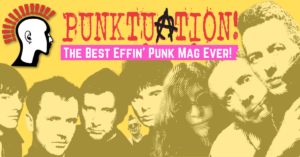While often lambasted in the ’70s as either Rolling Stones wannabes or for their shocking-at-the-time androgynous look – the Dolls are one of the greatest (often unsung) influences on punk rock. Molly Tie delves into what some consider one of punk’s first LPs.
In the wild cultural landscape that was New York in the 1970s, the outrageous rock band, the New York Dolls flamboyantly and unknowingly strutted their way into punk history. The New York Dolls did not think of themselves as punk rock because there was no such genre at the time. They were just another American garage band along the lines of the Velvet Underground, the Shaggs, MC5 and the Stooges (all of whom have legitimate claims to influencing punk too!)
However, New York Dolls would record what is today considered one of the most influential proto-punk albums ever – the eponymously titled New York Dolls. The look, the sound, the attitude, the drama – it was a quintessential punk recipe that would have both immediate and long-term effects on punk rock itself.

David Johansen, Johnny Thunders, Rock Rivets (replaced by Sylvain Sylvain the following year), Arthur Kane and Billy Murcia (replaced by Jerry Nolan after his death in 1972) began gigging around the small venues and dingy clubs of New York. This earned them a loyal local following who enjoyed their raucous live shows and their gritty yet entertaining music.
There was an eager audience for them in lower Manhattan. The previous decade the district was exposed to the kitschy Avant-Garde of the Warhol Factory, which meant there was an appetite for the weird and wonderful.
Despite the band’s expanding popularity, many record labels and producers were reluctant to sign them. Their penchant for drag, their reputation for excess and their unique sound were too much for the delicate sensibilities of the music establishment.
They were not considered an attractive prospect at a time when bands like the Bee Gees and The Osmonds were top of the charts along with prog-rock superstars such as Jethro Tull. At the time, it was believed they would never be anything more than a niche spectacle for the misfits of NYC.
One record company, however, had the foresight to take the chance and signed them up. That company was Mercury Records (eventual home of many glam rock/metal bands such as KISS and Def Leppard). New York Dolls set to work recording their debut album at The Record Plant in New York with pop and rock impresario Todd Rundgren in the role of producer.
Rundgren was considered an unusual choice- by the band and perhaps by Rundgren himself. He was not an enthusiastic fan of the band but had enjoyed their live performances at Max’s Kansas City: “The New York Dolls weren’t presented to me – they were just part of the milieu I was involved in at the time. ” Rundgren said. “I was still living in New York in an apartment that was walking distance from Max’s, which is where everything was happening. There was no CBGB yet.”

Rundgren had gained some success with his own 1972 release, ‘Something/Anything?’, and was regarded as a sophisticated producer who liked the intricacies of good pop songs, along the same vein as Phil Spector. Rundgren was a strict producer, not particularly in the mood for the band’s playful shenanigans and hangers-on who often crowded the studio.
“The challenge of making the record was that the control room was a freaking circus; everyone wanted to know what was going on with The New York Dolls,” he said.
Despite the circus, the album was recorded in eight days on a $17,000 budget, with the tracklist decided on as the recording process went on, based mainly on the reception the songs got from fans when played live.
The result? 11 songs of New York City sleaze, drama and heartbreak that capture the vibrancy of an eclectic city but also the tragic sense of overwhelming vulnerability and crisis that propels people through its underbelly.
When the album was released in 1973, they managed to be named both “Best New Band” and “Worst Band” in Creem Magazine’s annual reader’s poll, and it takes something special to polarise an audience like that.

The raw sound, the snotty vocal delivery, and the crude musicianship mean the album is considered one of the earliest examples of a punk record. But despite its acclaim for being rather ‘no frills’ – basic, it ain’t.
Musically, there is some play with different styles throughout the record, with diverse instrumentation from gongs to pianos, from saxophones to synthesizers. The combination of untrained musicianship (in the classical sense) with poignantly observational yet old school rock ‘n’ roll lyrics was electric. Their pared-back songwriting style and rebellious attitude were a prick in the pomposity of music that took itself too seriously- something it has in common with the wider punk movement.
There’s a touch of cabaret in the tinkling pianos in songs like Personality Crisis played by Rundgren and Sylvain on the grand piano in the studio. There’s an effort to create a sense of place with the use of gong at the beginning of Vietnamese Baby. Rundgren’s admiration for, and experience with, big pop production was put to good use, with the album considered to have signs of a Brill Building pop influence.
This style of songwriting and associated production was named after the Brill Building in New York, where teams of songwriters wrote hits for many girl groups and pop stars of the 1960s. It was considered a more sophisticated style of writing than was used until then, with contemporary production techniques that often featured bands with large rhythm and guitar sections or orchestral instruments. Rundgren was a fan, and so it seems was the band.

The outward campness of the band belied a more serious and deep take on the world contained in the lyrics. The lyrical themes always seemed to have the possibility of duel interpretation – a more dramatic light-hearted take and a more serious observation about the tendency of NYC to chew you up and spit you out, particularly the young and naïve.
We can see the city through the eyes of the characters in the songs – the thoughts and feelings of those who encounter its promises and sacrifices, the dreams versus the reality of life in a glitzy town, its exhilarating possibilities and its gut-wrenching pitfalls. There was a universal nature to the songwriting themes of youth angst, teenage alienation, romance and lust and the elusive nature of identity.
These wouldn’t be out of place in any songwriting genre or era. But it’s also of its time – speaking of contemporary life and the unique negotiations made by the band’s peers and neighbours. In these vignettes, there is no judgement. Drugs, sex, partying – necessary features of a life of survival. As Johansen sings in Subway Train:
I can’t ever understand
Why my life’s, been cursed, poisoned, condemned.
There’s an echo of the themes found in the pop groups of the previous decade in the songs about intense romance, and there’s even a nod to that influence at the beginning of the track Looking For A Kiss. Johansen opens the track by repeating the spoken words of Mary Weiss that open the Shangri La’s track Give Him A Great Big Kiss:
When I say I’m in love,
You’d best believe I’m in L-U-V.
The Shangri-Las influence went way beyond the confines of the ’60s girl group genre, and Rundgren was keen to incorporate some of their sounds due to the similarities between the band and the Dolls in terms of song themes and their ballsy New York attitude.
Hailing from Queens, The Shangri-Las were a welcome departure from the more saccharine-sounding groups of their peers who had a much more demure sound. They were famous for the ‘teen melodrama’ of their songs which is most demonstrable in their biggest hit, Leader of the Pack (poor Jimmy. RIP).
Their persona was of NYC tough girls, an image that their fans adored and which various rumours and innuendos sought to encourage. Their demeanour was one of teenage resilience. Their songs explored the less cutesy elements of being a teenager in the ’60s (or anytime for that matter)- running away, heartbreak and rebellion.
Johansen and co. may have been a darker version of the group, but there are definite similarities.
They stopped short of covering a Shangri-Las song, but one cover made it onto the album- a cover of the 1961 Bo Diddley track Pills. This was possibly the influence of Sylvain Sylvain, who was a huge Diddley fan as he recalls to the Village Voice in a 2011 interview:
“In 1972, David and I went to (legendary L.I. nightclub) My Father’s Place to see Bo. We were such rabid fans that we kept screaming out for “Pills,” which we covered the next year. We’re shouting, “Pills! Pills!” Bo had no idea why we were screaming this. David and I nearly got thrown out. People thought we were asking Bo if he had any drugs!”

The Doll’s debut album has definitely gathered more adulation and praise over the years, and perspective allows us to see the record’s significance. That wasn’t always the case. It was released in July 1973 in the USA and Oct 1973 in the UK; it was not initially a commercially successful album.
The cover was deliberately provocative, showing the band in full drag with make-up, high heels and ostentatious wigs with their band name scrawled in lipstick in the top left corner- the item’s similarity to a bullet perhaps a visual nod to the danger the band poses to the boring and complacent.
It was glitter with street smarts, an early fusion of glam hair metal and punk shock tactics. The polarising nature of the band was utilised as a marketing tool by Mercury records with advertising slogans such as ‘the band you’re gonna like whether you like it or not’ and ‘band you love to hate’.
Whilst not commercially successful, it was critically acclaimed with positive reviews in publications such as the NME (that considered it in the same light as Stooges Raw Power), The New Yorker, and Rolling Stone, to name a few.
But it is really the swathes of future stars who were fans of the band who elevated the significance of that first album. Morrissey claimed it was one of his favourite albums and was hugely impacted by the band since seeing them on the Old Grey Whistle Test in 1973.
The band’s influence can be heard in fellow New Yorkers the Ramones, who followed the Dolls just a couple of years later, as well as the Sex Pistols and the Clash across the pond in the UK.
The Dolls may not have sold the number of albums they deserved, but their influence is vast and incalculable. But one thing is certain; punk would not be what it is without them. Not a bad legacy!
NEW YORK DOLLS TRACK LISTING
| SIDE A | Title | Writer(s) | Length |
|---|---|---|---|
| 1. | “Personality Crisis“ | David Johansen, Johnny Thunders | 3:41 |
| 2. | “Looking for a Kiss” | Johansen | 3:19 |
| 3. | “Vietnamese Baby” | Johansen | 3:38 |
| 4. | “Lonely Planet Boy” | Johansen | 4:09 |
| 5. | “Frankenstein (Orig.)” | Johansen, Sylvain Sylvain | 6:00 |
| SIDE B | Title | Writer(s) | Length |
|---|---|---|---|
| 1. | “Trash“ | Johansen, Sylvain | 3:08 |
| 2. | “Bad Girl” | Johansen, Thunders | 3:04 |
| 3. | “Subway Train” | Johansen, Thunders | 4:21 |
| 4. | “Pills” | Bo Diddley | 2:48 |
| 5. | “Private World” | Johansen, Arthur Kane | 3:39 |
| 6. | “Jet Boy“ | Johansen, Thunders | 4:41 |
If ya liked this…check out these…
- Legendary NYC rocker Sonny Vincent is back with a new video from his first new solo album in seven years.
- Berlin’s Legendary Club SO36 Keeping The Punk Spirit Alive
- Machine Gun Kelly and Travis Barker get matching tatts to reveal new album title
- Billy Idol releases new song, ‘Bitter Taste,’ from forthcoming EP
- Is Time Up For Popular Aussie Punks WAAX?
- Mark Illuminati: My Punk Top Ten
- Belvedere Announce Canadian Tour Dates
I’m Molly Tie- I Love punk! I play drums (badly), write a lot about punk (not as badly) and I’m particularly interested in issues relating to women in the music scene.




 Did you know that we are 100% DIY? We run our own game. No one dictates to us, and no one drives what we can or cannot put on our pages – and this is how we plan to continue!
Did you know that we are 100% DIY? We run our own game. No one dictates to us, and no one drives what we can or cannot put on our pages – and this is how we plan to continue!
